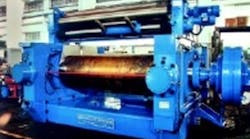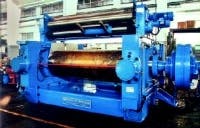Elastomers and natural and synthetic rubbers distinguish themselves from other plastics by their high elasticity.
Duplomatic has developed an electronic control for a series of open mixing machines manufactured by Meccaniche Moderne SpA, Busto Arsizio, Italy. The system can also be applied to other open mixing machines, as well as to existing machines for updating to the latest health and safety standards.
Machines such as these are used for mixing and rolling a sheet of rubber with variable thickness. The hydraulic control — developed by Duplomatic, Legnano, Italy, in collaboration with Meccaniche Moderne — is able to maintain the positioning precision of the adjustable cylinder, within a tolerance of ±0.01 mm.
To maintain this tolerance, the machine requires a closed-loop control ensuring both roller position and accurate sheet thickness across the full width of the sheet. Duplomatic's DCU card maintains this tight tolerance by providing digital control of the machine's position loop.
Furthermore, the machine's setup times have been greatly reduced, thanks to the automatic cycle of calibration and self-learning of the DCU card. This cycle enables the operator to calibrate the gap between the machine's two axes of fixed and adjustable cylinders. This operation is controlled through the machine's PLC or by a remote control supplied by Duplomatic. The parameters of the position loop can be digitally optimized for every axis.
The system not only provides precise gap control, but also controls position of the two cylinder axes as well. This achieves high parallelism, which maintains a uniform thickness of the material throughout its entire width.
The control also allows quick opening of the rolls in case of emergency. This is accomplished with supplemental flow from an accumulator. This setup avoids counter-rotation of the cylinders that otherwise would occur at the end of the emergency procedure — a dangerous operation and the major cause of accidents on these machines.
Material on this page was provided by Greta Mancinelli, of Duplomatic, www.duplomatic.com. Duplomatic products are available in the U. S. from Universal Hydraulics International Ltd. For more information, call (330) 405-1800, or e-mail [email protected].


